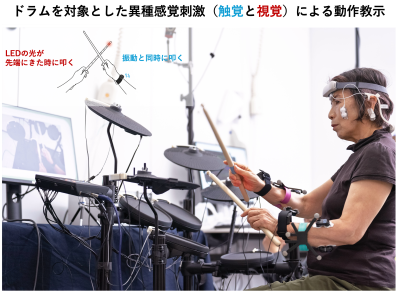[Initiative Introduction] - Supporting physical movement through sensory stimulation
Category:News|Publishing : October 15, 2025
Our bodies are constantly receiving information from the outside world and using that information to decide what action to take next. When the body moves, it predicts the movements and sensations that will result from that movement and adjusts the movement by comparing these with the sensory feedback that is actually obtained from the movement. When these predictions and results are consistent, a sense of "body ownership" arises, a feeling that the body is one's own, and a sense of "motor agency" arises, a feeling that one caused the movement.
On the other hand, our body awareness is flexible, and it is known that we can feel a sense of body ownership and agency even when it comes to external machines, stimuli, and the movements that result from them. This flexible body recognition characteristic can also be applied to motion instruction used in skill learning. Traditionally, when learning skills such as sports, craftsmanship, or playing a musical instrument, audiovisual information has been used primarily. However, in recent years, systems have been developed that more directly and efficiently teach appropriate movements by presenting sensory stimuli and guiding physical movements using external devices.
It is known that when teaching movement using sensory stimuli, learners are more likely to feel a sense of agency because they interpret and utilize the stimuli themselves. Assistant Professor YUKAWA Hikari (Nagoya Institute of Technology, Electrical and Mechanical Engineering Group) has developed a support system for drumming that uses sensory stimulation and is working on applying it to preventing frailty in the elderly. Frailty refers to a condition in which cognitive and physical functions gradually decline with age, and it is said that the key to preventing this is to "achieve moderately strenuous exercise on your own." Playing the drums requires moving each hand at different times, making it a moderately strenuous exercise for the elderly.
For elderly people to effectively learn these exercises, it is necessary to devise methods for presenting sensory stimuli that take cognitive load into account. For example, the system developed by Assistant Professor YUKAWA uses a method to present movements by combining different sensory modalities: visual and tactile stimuli. Cognitive neuroscience research has shown that heterogeneous sensory stimuli are less likely to interfere with each other and are easier to recognize than homogeneous sensory stimuli. In fact, it has been shown that using both vision and touch for each hand reduces the discrepancy with the timing of the model compared to using only vision for both hands. By utilizing this system, elderly people can now perform complex drum performances with multiple overlapping rhythms. Furthermore, efforts are underway to obtain a more detailed understanding of changes in brain function and the level of proficiency in movements by acquiring and analyzing biometric information such as electroencephalograms and myoelectric potential.
[Comment from Assistant Professor YUKAWA]
By controlling and personalizing the presentation of these sensory stimuli according to the individual's condition as inferred from biometric information, it may be possible to provide more effective movement support that gives a greater sense of agency. Moreover, these systems are not just for single-person use; by expanding them to allow multiple people to work collaboratively while sharing their senses, it is expected that they will contribute to maintaining and improving motivation and fostering social connections.
Furthermore, this type of movement support is not limited to the elderly. Even if you don't have a physical or cognitive disability, there are probably many people who struggle with things like being clumsy with their hands or having no sense of rhythm. This type of support may be a tool that lowers the hurdles to taking on new challenges, even for those everyday difficulties.
In the future, it is expected that by appropriately combining devices that directly intervene in physical movements mechanically and electrically, the system will be expanded to enable more immediate skill performance while maintaining a sense of agency. A future in which skills can be freely utilized as needed, such as "Today is my child's birthday, so let's install the pastry chef skills and make a homemade cake!", is not a dream.

Related Website
RESEARCH NEWS - Towards New Ionic Liquid-Modified Zeolite Membranes for Efficient CO2 Conversion [Initiative Introduction] - Pioneering a prosperous future through materials research into all-solid-state batteries

 Japanese
Japanese